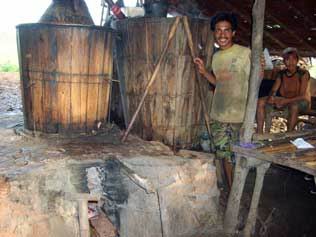Cajeput Oil: Buru Island, Maluku
 Visitors to Buru Island, Maluku, often purchase bottles of cajeput oil to take home as gifts. Buru Island is renowned for its high quality cajeput oil and is teeming with cajeput forests, especially in the Namlea, Waplau and Waeapo districts. Residents of Buru Island generally sell the medicinal oil, derived from cajeput or Melalueca leucadendron trees, in used and unlabeled bottles. Prices range from between Rp 40,000 (approximately US$4.50) and Rp 80,000, depending on the size of the bottle as M. Azis Tunny writes.
Visitors to Buru Island, Maluku, often purchase bottles of cajeput oil to take home as gifts. Buru Island is renowned for its high quality cajeput oil and is teeming with cajeput forests, especially in the Namlea, Waplau and Waeapo districts. Residents of Buru Island generally sell the medicinal oil, derived from cajeput or Melalueca leucadendron trees, in used and unlabeled bottles. Prices range from between Rp 40,000 (approximately US$4.50) and Rp 80,000, depending on the size of the bottle as M. Azis Tunny writes.
The oil is highly sought after due to its remedial properties. It is believed to cure a number of ailments including rheumatism, ulcers, diarrhea, skin problems, fever and flu.
Local residents have different methods of determining the quality of cajeput oil, such as placing their eye at the opening of the bottle to test its sting and shaking bottles to test the subsequent reaction.
During the New Order period, Buru Island, which lies west of Ambon Island, was notorious as a place of exile for political prisoners.
One of its more well-known occupants was the late Pramoedya Ananta Toer, a Nobel-prize nominated writer who published many literary works on social realism themes, including Bumi Manusia (Human’s Earth), Anak Segala Bangsa (Child of All Races), Rumah Kaca (Glass House) and Jejak Langkah (Footstep). Pramoedya wrote these novels, known as the Buru Tetralogy, during his exile days on the island.
To reach Buru Island, visitors can take a three-hour speed boat journey from Ambon city to the island’s Namlea Port. As the boat approaches the port, rolling barren hills and savanna plains teeming with cajeput trees emerge. On Buru island there are scarcely any other types of trees.
Buru Island’s arid and humid climate as well as its low rainfall allow cajeput trees to thrive. According to tests conducted by the Center for Research and Development of Biotechnology and Forest Tree Improvement in Yogyakarta, the quality of cajeput oil produced on Buru Island surpasses that produced in Papua and Australia.
However, traditional distillers of the product on the island often do not reap the benefits of this popularity due to middlemen who have the power to dictate prices. These middlemen are able to gain a higher profit compared to that of distillers, who are often also forced to rent distilling equipment.
Local residents continue to use simple and conventional methods to process cajeput oil. Each ketel, or distillery, is operated by two or three families who work on a profit-sharing basis. Some also work extra hours at other distilleries.
New residents of Buru Island also operate a number of cajeput oil distilleries. Many of these people are from Buton Island in Southeast Sulawesi.
A ketel is a very simple facility with a thatched roof, wooden walls and an earthen floor.
La Kara, 30, works as a distiller at a ketel in Gunung Kersen in Namlea district along with 13 colleagues. Although he lives only four kilometers from his workplace, he is often forced to spend several days at a time working at the ketel.
“My duty is to feed wood into the furnace to keep it burning and always ensure fresh leaves are being added. This work takes hours, and can even last from one morning to the next,” he said.
The father of five virtually has to work non-stop to keep the furnace burning. He often has to sleep at his workplace and rarely finds time to see his family.
Kara and his colleagues work for Fery Tanayav, an Indonesian-Chinese entrepreneur who provides them with distilling equipment and five hectares of cajeput forest from which raw materials are harvested to produce the oil.
The distillery can produce six to eight kilograms of cajeput oil per day, depending on the amount of leaves available. During the dry season, many cajeput farms catch fire, causing production to be suspended.
In producing the oil, a contract system is generally used. For example, if one hectare of cajeput forest can produce 300 kg of cajeput oil, the financier receives 200 kg and the remaining 100 kg will be divided equally among workers.
“We usually receive Rp 3 million (US$335) for five months work, but sometimes less than Rp 2 million,” said Kara.
Kara is forced to borrow between Rp 100,000 and Rp 200,000 per month to meet the needs of his family and to pay for his children’s education.
“If there were other jobs available, I would stop working at the distillery because there is no hope there. I find it difficult to pay for my children’s education, even though they are still at elementary school,” he said.
There are no specific plantations of cajeput trees on Buru island, with trees growing naturally in the forest or on the land of residents.
Cajeput trees can be found on more than 120,000 hectares of land on the island, with a density of 100 to 160 trees per ha. In areas where cajeput leaves are harvested intensively, trees range in height between one and two meters however can grow up to a height of 25 meters.
Based on data from Buru Island’s forestry office, a fire destroyed more than 1,000 ha of cajeput trees during a drought in 2006.
M. Azis Tunny